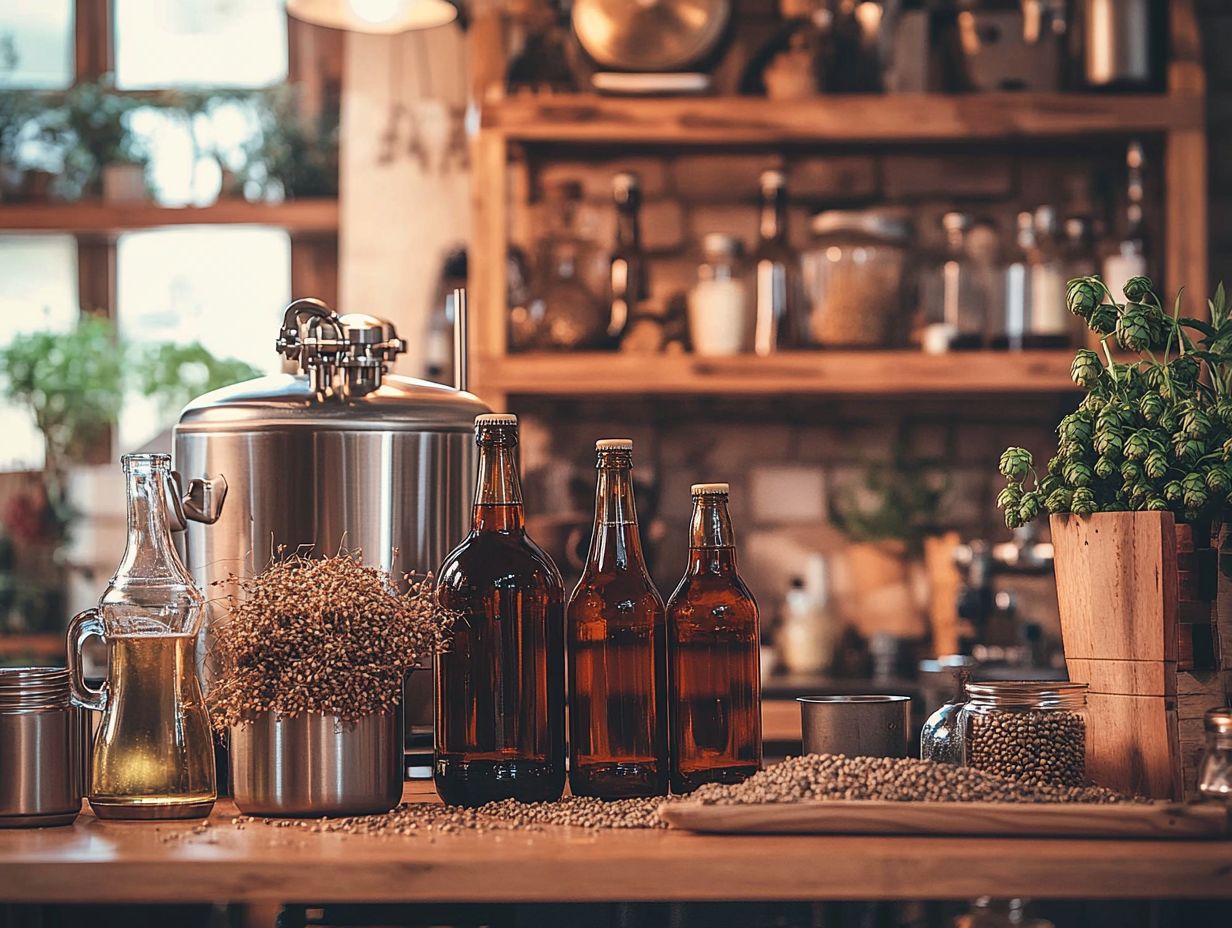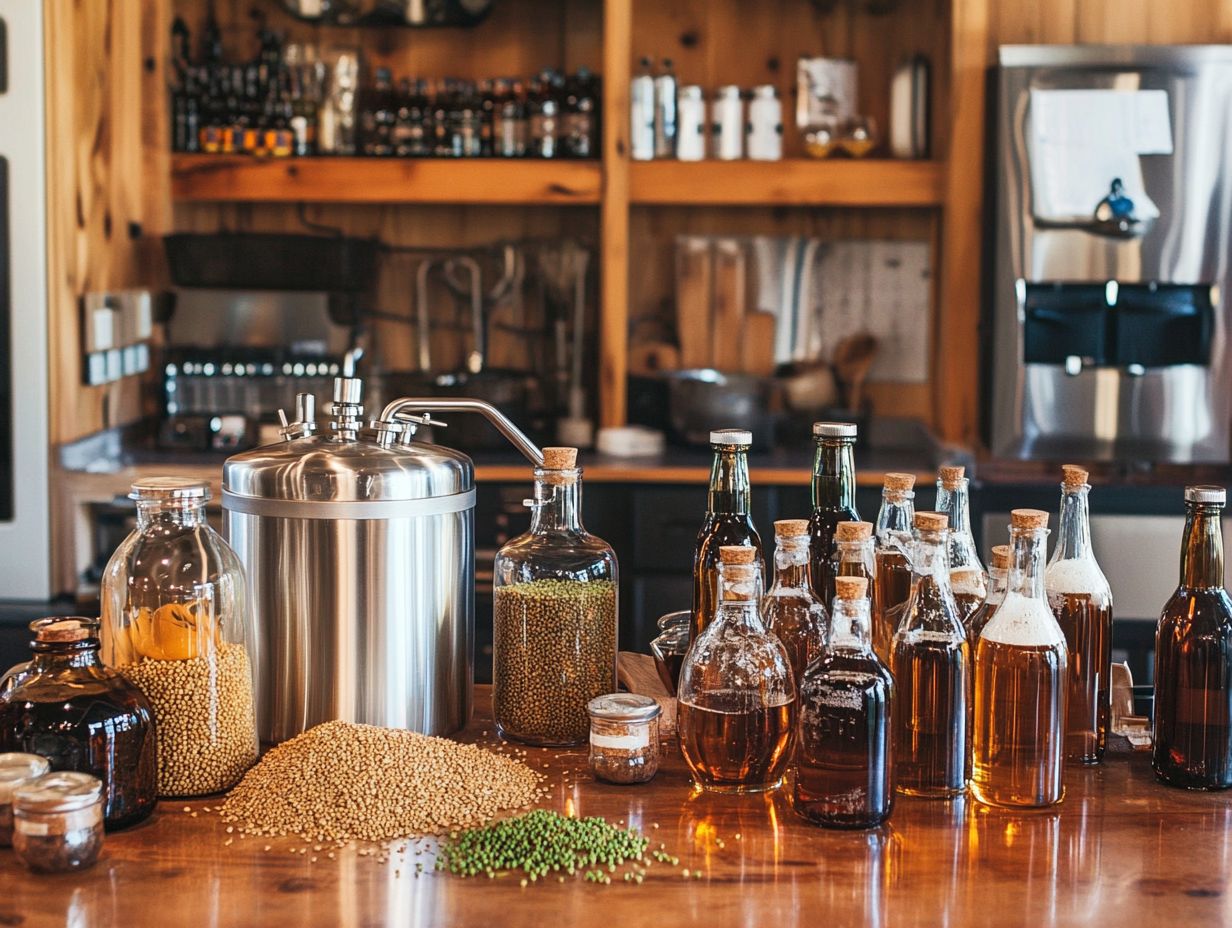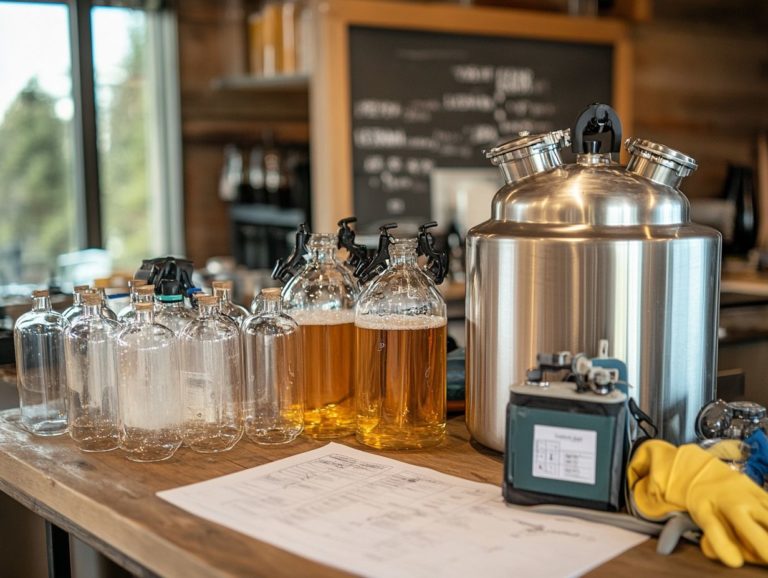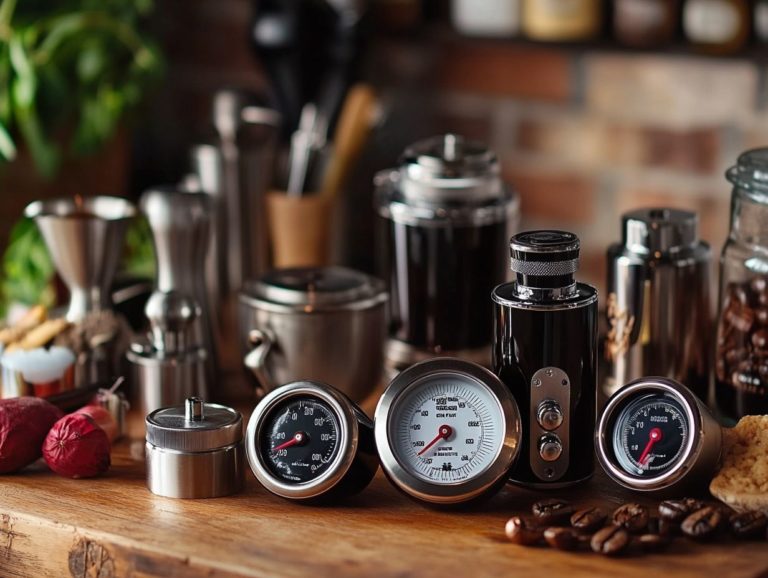5 Common Home Brewing Equipment Myths
Home brewing often carries with it a cloud of misconceptions that can dissuade even the most eager beginners. You might believe that brewing a respectable batch requires a small fortune in equipment or that it’s a time-consuming, intricate process meant only for seasoned experts. These myths can create unwarranted hurdles on your brewing journey.
Let s clear the air about home brewing myths by debunking five prevalent misconceptions, delving into the essential gear you’ll need, and offering practical tips to help you embrace this fulfilling hobby without draining your wallet or feeling overwhelmed.
Whether you’re a curious novice or a seasoned brewer, you’ll find valuable insights and guidance tailored just for you.
Contents
- Key Takeaways:
- 1. You Need Expensive Equipment to Brew Good Beer
- 2. Home Brewing Is Time-Consuming and Difficult
- 3. You Need a Lot of Space to Brew Beer at Home
- 4. Brewing Beer at Home Is Only for Beer Experts
- 5. Home Brewing Can Save You Money
- What Equipment Do You Really Need to Brew Beer at Home?
- Frequently Asked Questions
- Conclusion
- What are the 5 common home brewing equipment myths?
- Is it true that you need expensive equipment to make good beer?
- Do I need a lot of equipment to make good beer?
- Can I use any type of pot to boil my wort?
- Do I really need a hydrometer to measure my beer’s gravity?
- Are cleaning and sanitizing important in home brewing?
Key Takeaways:

- Home brewing can be done with affordable equipment; you don’t need expensive gear to make great beer.
- Brewing beer at home doesn’t have to be a difficult or time-consuming process. With the right equipment and knowledge, it can be a fun and rewarding activity.
- You don’t need a huge amount of space to brew beer at home; a small area or even a kitchen can suffice.
1. You Need Expensive Equipment to Brew Good Beer
Many aspiring home brewers often fall into the trap of thinking that crafting high-quality beer demands an extravagant investment in pricey equipment. However, the reality is that you can achieve brewing success with a modest setup that prioritizes essential components, brewing techniques, and a steadfast commitment to cleanliness and quality.
Esteemed brewers like Charlie Papazian emphasize that a deep understanding of the brewing process from fermentation to bottling holds far more significance than the cost of your gear.
In truth, the fundamental tools for home brewing like fermentation chambers, basic brewing tanks, and simple sanitization equipment are quite affordable, making this rewarding hobby accessible to a broader audience of enthusiasts. Even entry-level setups can yield remarkable results when you dedicate time to learning and applying effective methods, focusing on the brewing process and brewing techniques.
Many novice brewers have managed to produce exceptional beer without the flashy bells and whistles of high-end equipment, proving that affordability doesn t equate to a compromise on quality.
As Papazian would remind you, it s your passion and persistence, rather than the price tag, that truly define a successful brew day. Remember, brewmaster skills are developed over time with practice and patience.
2. Home Brewing Is Time-Consuming and Difficult
While home brewing might initially appear time-consuming and complex to you as a newcomer, it s important to understand that with careful planning, patience, and a structured approach to the fermentation process, you can easily craft delicious beer at home without being overwhelmed by the intricacies of brewing. Key aspects such as controlling temperature and understanding water composition play vital roles in the brewing process.
The entire brewing journey typically unfolds over several weeks, usually involving fermentation periods that last from one to two weeks, depending on the type of beer you re producing. This waiting game is essential, as it allows the flavors to develop fully and the alcohol content to stabilize, underscoring the vital role patience plays in the process. During this period, managing secondary fermentation and trub (the sediment left after fermentation) can significantly impact the final product.
You can streamline your brewing experience by breaking it down into manageable steps, such as:
- Mastering sanitation
- Understanding the fermentation stages
- Carefully monitoring each phase
Ultimately, this approach not only makes the entire process less daunting but also leads to the immensely rewarding experience of sampling a beverage crafted by your own hands, deepening your appreciation for the art of brewing and the myriad flavors it can produce.
Now that you ve dispelled some myths about home brewing, why not give it a try? Start your brewing journey today and share your experiences with fellow enthusiasts!
3. You Need a Lot of Space to Brew Beer at Home
A prevalent myth about homebrewing is that it requires significant space; however, many accomplished brewers have shown that you can craft quality beer easily in small, dedicated areas. With the right organization and equipment, even compact environments can yield exceptional results.
By emphasizing the use of compact brewing tools and clever storage solutions, you can transform any corner of your home into a functional brewery. For example, a fermentation chamber that fits snugly in a closet allows for precise temperature control while preserving valuable floor space. Smaller fermenters can also be a game changer, occupying less room and enabling you to experiment with different brewing styles, such as Belgians or porter.
Incorporating wall-mounted racks for tools and ingredients keeps everything organized and readily accessible. This strategy not only maximizes your available space but also encourages creativity, proving that a passion for brewing can flourish, no matter the size of your environment.
4. Brewing Beer at Home Is Only for Beer Experts

The idea that home brewing is an exclusive club for beer aficionados is simply not true; in fact, anyone with a genuine passion for craft beer and a desire to learn can dive into the world of homebrewing. With accessible techniques and resources available, you can create quality brews that cater to your unique taste preferences. Whether you choose all-grain or extract methods, success is within reach.
As a beginner, you ll find a wealth of options available to you. You can opt for all-grain brewing, which gives you greater control over the entire process, or you might prefer the simpler extract methods that deliver satisfying results without requiring a hefty initial investment.
The home brewing community is incredibly welcoming, with forums, local clubs, and workshops designed to guide newcomers through every step of their brewing adventure. An abundance of educational resources from online tutorials to insightful brewing books exists to ensure that even if you ve never brewed before, you’ll quickly master the basics and enjoy the thrill of brewing. Many beginners start with liquid yeast or dry yeast to suit their brewing conditions.
5. Home Brewing Can Save You Money
Many people think that home brewing is an expensive hobby, but if you take a closer look, you’ll find that producing quality beer at home can actually save you a considerable amount over time compared to consistently buying craft beer especially as your skills improve and your production methods become more refined.
With the right approach to extract brewing or all-grain brewing, you can optimize both cost and quality. By making an initial investment in key equipment like fermenters, brewing kettles, and bottling supplies, you ll likely notice a marked decrease in your overall beer expenses.
For instance, while a six-pack of quality craft beer can easily set you back over $10, brewing the same quantity at home can often be achieved for a fraction of that cost. Utilizing an RO filter, which purifies your water, and a campden tablet, which removes chlorine, can further enhance your brew’s quality.
As you hone your skills and perfect your recipes, those cost savings become even more significant, transforming home brewing into not only a creative outlet but also a financially astute decision for those who truly value their beer. You also gain satisfaction from crafting your own personalized brew, which adds immense value that goes far beyond just the monetary aspect.
What Equipment Do You Really Need to Brew Beer at Home?
When you embark on your home brewing journey, it s essential to know exactly what equipment you need. While a vast array of brewing gadgets awaits you, honing in on the essentials like fermentation vessels, brewing tanks, and cleaning supplies that keep your equipment safe can significantly elevate your brewing experience without straining your budget.
For newcomers to this craft, your must-have list begins with a fermentation vessel, the cornerstone for transforming raw ingredients into your finished masterpiece. A reliable airlock is crucial too, as it regulates pressure during fermentation. Additionally, a brewing kettle ensures that heat is evenly distributed during the boiling process. Don t overlook sanitation products; a good sanitizer is non-negotiable since preventing contamination is vital to achieving that perfect brew.
After covering the basics, consider adding some nice-to-haves such as a hydrometer to measure fermentation progress or a wort chiller for rapid cooling post-boil. By paying careful attention to cleanliness and choosing the right equipment, you ll be on the fast track to brewing success. Proper temperature control with devices like Inkbird can also enhance the outcome.
What Are the Steps Involved in Home Brewing?
Home brewing is an art that unfolds through a series of meticulously defined steps. When you approach each stage with care, you ll find yourself well on your way to crafting delicious beer. It all starts with gathering quality ingredients and preparing the wort, followed by managing fermentation and bottling each phase plays a vital role in your brewing success. Understanding the importance of water composition and chlorine levels can significantly affect the final product.
Your journey begins with the careful selection of malts, hops, and yeast. These elements are crucial as they significantly influence the flavor profile of your brew. Once you’ve made your choices, the next critical step is wort preparation. Here, you ll steep the malts in hot water to extract the sugars, then boil them with hops to infuse bitterness and aroma. Techniques like batch sparging and no-sparge can also be applied depending on your preference.
As the wort cools, you transition into the fermentation management phase. This is where you introduce the yeast, setting in motion a magical transformation that turns your wort into alcohol, all while carbon dioxide is produced. Maintaining consistent temperatures during fermentation is vital to achieving the desired results. Using liquid malt extract can also optimize your brewing techniques.
Finally, patience becomes your best friend during the bottling stage. Here, you ll siphon the beer carefully to avoid sediment, cap it, and let it carbonate before you can indulge in your creation. Quality control at each step is essential, ensuring that the final product is a testament to your dedication as a brewer. Using no-sparge techniques can sometimes enhance the flavors and reduce the effort during this stage.
What Are Some Common Mistakes to Avoid When Brewing at Home?

As a novice home brewer, you may encounter common pitfalls that could negatively impact the quality of your beer. By being mindful of these mistakes like neglecting cleanliness, mismanaging fermentation temperatures, and overlooking trub, hop residue, and condensation you can significantly enhance your chances of brewing success.
It’s essential for anyone diving into the world of brewing to prioritize sanitation practices. Unwanted bacteria can quickly spoil an otherwise well-crafted batch, so keep your brewing environment spotless. Consistency in fermentation conditions is also vital; temperature fluctuations can lead to off-flavors and an unpredictable brewing process. Using a fermentation chamber can help manage these conditions effectively.
Don’t underestimate the importance of fermentation time either. Monitoring yeast activity and recognizing the signs of a properly completed fermentation can elevate your final product. By focusing on these crucial details, you can refine your brewing technique and bask in the rich satisfaction that comes from crafting exceptional beer. As Charlie Papazian, a notable figure in homebrewing, often emphasizes, “Relax, don’t worry, have a homebrew.”
Get ready to impress your friends with your homemade beer! Start your brewing adventure today!
How Can You Make Home Brewing More Efficient?
Efficient home brewing combines effective techniques, high-quality equipment, and a keen understanding of brewing science to streamline processes and enhance results.
You can significantly enhance your home brewing efficiency by embracing streamlined processes, effective temperature control, and innovative techniques that reduce both the time and effort required to craft quality beer all without compromising on taste. Using a high-quality RO filter can improve water quality, which is crucial for brewing.
Consider implementing strategies such as batch sparging, a method to rinse grains for more sugar extraction while minimizing water usage. This is essential for optimizing your labor and resources. Using fermentation chambers helps you maintain precise temperature control, ensuring that your yeast operates at its peak performance, which results in a cleaner fermentation process. Innovative equipment like Inkbird temperature controllers can make this task easier and more efficient.
Simplifying your equipment setup not only cuts down on the complexity of brewing but also helps preserve the essential flavors that define each brew. Ultimately, the goal is to achieve a harmonious balance, allowing you to enjoy an efficient brewing experience without sacrificing the rich and distinct flavors you cherish. Brands like Craftmaster Stainless and Brewing Association offer durable and effective brewing tanks that can streamline your process.
What Are Some Tips for Choosing the Right Home Brewing Equipment?
Selecting the right home brewing equipment is crucial for achieving the quality results you desire. By considering factors such as your brewing goals, available space, budget, and the type of beer you wish to create, you can make informed choices that elevate your brewing experience. For example, investing in durable brewing tanks can significantly enhance your homebrew setup.
Exploring various brewing methods is essential. Certain equipment may be more suitable for all-grain brewing, while others shine in extract brewing. Assess whether the equipment aligns with your preferred method, as this compatibility can significantly influence both the brewing process and the final product. Methods like decoction mashing can also offer unique benefits for certain styles of beer.
Prioritizing quality materials is equally important. Investing in durable equipment enhances your brew quality and minimizes the need for frequent replacements. While you navigate the balance between cost and functionality, remember that opting for cheaper options may save you money upfront but could compromise performance or longevity. Weigh your options carefully for long-term satisfaction and success in your home brewing journey. Consider high-quality brands like Craftmaster Stainless for reliable performance.
How Can Home Brewing Save You Money in the Long Run?
While the initial investment in home brewing equipment might seem substantial, the long-term savings from producing your own beer can far outweigh those expenses. For beer enthusiasts who value quality and variety, home brewing is a financially savvy choice. You can experiment with Belgian styles and other unique brews that aren’t always available commercially.
With the rising prices of commercially brewed beers often burdened by hidden costs like transportation and marketing you’ll quickly realize how much money you can save by brewing your own beer at home! Crafting your beverages allows you to experiment with a range of flavors and styles that store-bought options simply can t match. Brewing your own lets you delve into Belgian styles and local favorites.
This creative outlet allows you to brew superior quality beers tailored to your personal taste preferences, ultimately leading to significant savings over time. As you immerse yourself in home brewing, you’ll find that the cost-effectiveness and sheer enjoyment of this hobby become increasingly evident. Knowledge of homebrew myths can help you avoid unnecessary expenses and focus on what truly matters.
Frequently Asked Questions

Conclusion
By investing in the right equipment, exploring various brewing methods, and understanding the benefits of home brewing, you can elevate your brewing experience while saving money in the long run. Start your home brewing journey today and enjoy the quality and flavors that come from crafting your own beer!
What are the 5 common home brewing equipment myths?
Understanding these homebrew myths can help you make smarter choices and avoid unnecessary complications in your brewing process.
The 5 common home brewing equipment myths are:
You need expensive equipment to make good beer.
The more equipment you have, the better your beer will be.
You can use any type of pot to boil your wort.
You don’t need a hydrometer to measure your beer’s gravity.
Cleaning and sanitizing are not that important in home brewing.
Is it true that you need expensive equipment to make good beer?
No, it is not true. While some high-end equipment may improve the quality of your beer, it is not necessary to make good beer.
Many home brewers have created award-winning beers with simple, affordable equipment.
Do I need a lot of equipment to make good beer?
No, you do not need a lot of equipment. In fact, some experienced home brewers prefer to keep their setup simple and use only basic equipment.
The key to making good beer is understanding the brewing process and having good quality ingredients. Even simple setups can benefit from liquid malt extract for easier brewing.
Can I use any type of pot to boil my wort?
No, you cannot use any type of pot. It is important to use a large, stainless steel pot to boil your wort.
Using a smaller pot or one made of a different material can affect the flavor of your beer and potentially lead to contamination.
Do I really need a hydrometer to measure my beer’s gravity?
Yes, a hydrometer is an essential tool in home brewing. It allows you to accurately measure the sugar content of your wort and monitor the fermentation process.
Without a hydrometer, it is difficult to achieve consistent and high-quality results.
Are cleaning and sanitizing important in home brewing?
Yes, cleaning and sanitizing are crucial steps in home brewing. Any equipment or surfaces that come into contact with your beer must be properly cleaned and sanitized to prevent contamination and off-flavors.
Using a campden tablet can help neutralize chlorine in your water, making it safer for brewing. Neglecting this step can result in spoiled or undrinkable beer.
Now that you know the truth behind these common myths, you can brew with confidence!






